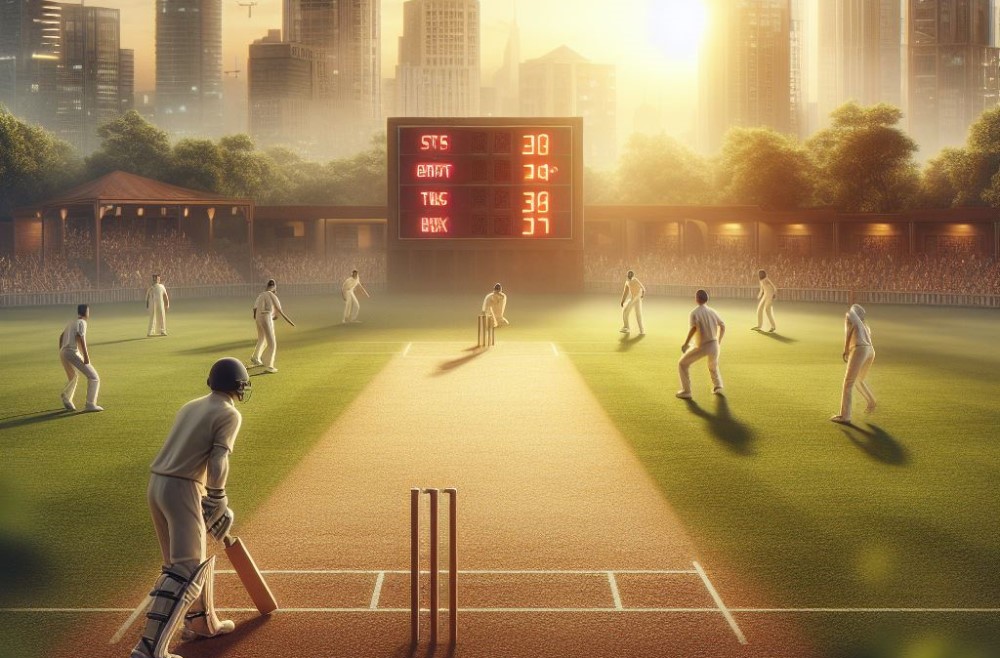
What Is The Duckworth-lewis Method
The Duckworth-Lewis method is a mathematical formula used throughout cricket history to determine the target score for the team batting second in rain-affected matches. Named after its developers, Frank Duckworth and Tony Lewis, this method has revolutionized the way target scores are calculated in limited-overs cricket.
The history and development of the Duckworth-Lewis method are fascinating. The method was first developed in the 1990s as a response to the limitations of the previous rain rule, the Average Run Rate method. The aim was to create a more accurate and fair system for determining target scores in rain-affected matches.
The Duckworth-Lewis method was officially implemented by the International Cricket Council (ICC) in 1997 and has since been used in numerous international matches, including World Cups and bilateral series. Its introduction brought a level of fairness and accuracy to the game, ensuring that rain interruptions no longer overly disadvantage any team.
To understand the Duckworth-Lewis method, it is essential to grasp how it works and the factors it considers. The method takes into account the number of overs remaining, the number of wickets lost, and the scoring rate of the team batting first before the rain interruption.
It then recalculates the target score for the team batting second, adjusting it based on the resources available to them.
The practical application of the Duckworth-Lewis method comes into play during rain-affected matches. When rain interrupts play, the umpires refer to the Duckworth-Lewis method to determine the revised target for the chasing team. This ensures a fair outcome, where teams have a realistic chance of reaching the target within the reduced overs.
However, like any system, the Duckworth-Lewis method does have its limitations and criticisms. Critics argue that it may still not accurately reflect the match situation after a rain interruption or that it can lead to complex calculations that may confuse players and fans.
To further understand the working of the Duckworth-Lewis method and its impact on cricket matches, it is worthwhile to explore examples and case studies where the method has been used, analyzing its effectiveness and the resulting outcomes.
By delving into specific instances, we can gain a comprehensive understanding of the Duckworth-Lewis method and its role in ensuring fairness in rain-affected cricket matches.
History and Development of the Duckworth-Lewis Method
The Duckworth-Lewis method, developed by statisticians Frank Duckworth and Tony Lewis in the 1990s, is a mathematical approach used to determine target scores in rain-affected cricket matches. Originally involving a complex formula, it underwent simplification in 2014 to enhance its comprehension.
Taking into account the number of overs remaining and wickets lost by the team batting second, this method has revolutionized limited-overs cricket by ensuring fair outcomes in rain-interrupted games.
In the context of history and development of the Duckworth-Lewis method, it is reminiscent of the 2019 Cricket World Cup match between India and New Zealand, which was significantly affected by rain.
In this match, the Duckworth-Lewis method played a crucial role in recalculating the target for India. Despite their valiant efforts, India fell short by 18 runs, resulting in their elimination from the tournament.
How was the Duckworth-Lewis Method Developed?
The Duckworth-Lewis Method was developed by statisticians Frank Duckworth and Tony Lewis in the 1990s. They used mathematical models to create a fair and accurate method for adjusting targets in rain-affected cricket matches.
To understand how the Duckworth-Lewis Method was developed, Duckworth and Lewis extensively analyzed large amounts of historical match data.
Their goal was to identify patterns and factors that influenced scoring rates. By formulating equations that take into account the number of overs remaining, wickets lost, and resources available to both teams, they were able to create a method that can be used in rain-interrupted matches around the world.
Consequently, the Duckworth-Lewis Method was first implemented internationally in 1997 and has since gained widespread acceptance.
When was the Duckworth-Lewis Method First Implemented?

The Duckworth-Lewis method was first implemented in international cricket in 1997. It was created by statisticians Frank Duckworth and Tony Lewis to address the issue of rain-affected matches.
Before its introduction, matches interrupted by rain would often end in a draw, leading to frustration for both players and fans. The method calculates revised target scores for teams based on various factors such as overs remaining, total runs scored, and wickets lost.
This ensures a fair outcome in rain-affected matches. Since its implementation, the Duckworth-Lewis method has been widely accepted and adopted in cricket tournaments around the world.
Considering the significance of accurate calculations in cricket, the implementation of the Duckworth-Lewis method has revolutionized the way rain-affected matches are decided.
Its introduction has provided a fair and objective approach to determining revised target scores, ensuring that matches can continue despite interruptions.
This has greatly enhanced the excitement and competitiveness of cricket matches, allowing players to showcase their skills and fans to enjoy thrilling encounters, even in challenging weather conditions.
Understanding the Duckworth-Lewis Method
It is crucial to have a clear understanding of the Duckworth-Lewis method in cricket. This method is used as a rain rule to determine targets in matches affected by rain. The target is adjusted based on the number of overs remaining and the number of wickets lost.
Consideration of key factors such as the score at the time of interruption, expected run rate, and resources remaining is important when comprehending this method.
To better comprehend its impact on the outcome of a match, it is recommended to familiarize yourself with the method’s calculations and various scenarios.
How Does the Duckworth-Lewis Method Work?
The Duckworth-Lewis method, used in cricket, is a mathematical formula that determines the target score for the team batting second in rain-affected matches.
It takes into account the resources available to the team, such as overs and wickets, and calculates a revised target based on the scoring patterns of the team batting first.
The method incorporates a complex algorithm that considers the number of overs played, the number of wickets lost, and the current run rate.
This ensures a fair outcome by adjusting the target score to reflect the lost playing time. Over the years, the Duckworth-Lewis method has been fine-tuned to provide accurate results in rain-affected matches.
What Factors Does the Duckworth-Lewis Method Consider?
The Duckworth-Lewis method takes into account several factors to determine revised targets in rain-affected cricket matches. These factors include the number of overs left to be bowled, the number of wickets lost by the team batting first, and the number of runs scored by the team batting first.
The method considers the resources available to both teams, such as the number of overs they have to utilize. By taking these factors into consideration, the Duckworth-Lewis method aims to provide a fair and balanced outcome in matches affected by rain.
Application of the Duckworth-Lewis Method in Cricket

When it comes to cricket, the application of the Duckworth-Lewis method is an essential tool used to determine the target score for the team batting second in a rain-affected match.
This method takes into account the available resources and the number of overs lost due to rain interruptions. The application of the Duckworth-Lewis method in cricket ensures fairness and allows for a balanced result, even in matches affected by weather conditions.
It enables teams to set realistic goals and strategize accordingly, making the game more exciting and challenging for both teams.
How is the Duckworth-Lewis Method Used in Rain-Affected Matches?
The Duckworth-Lewis method is a crucial tool used in rain-affected cricket matches to adjust the target score for the team batting second.
So, how is the Duckworth-Lewis method used in rain-affected matches? Let’s walk through the steps involved:
- Firstly, when rain interrupts play, the number of overs to be bowled is reduced.
- Next, the resources of the team batting second, including wickets in hand and overs remaining, are taken into account.
- A par score is then calculated, considering the run rate of the team batting first at the time of the interruption.
- Based on the number of overs lost, the team batting second is given a revised target, which is the par score adjusted accordingly.
- In order to win the match, the team batting second must score more runs than the revised target.
The Duckworth-Lewis method, developed by statisticians Frank Duckworth and Tony Lewis in the 1990s, has become the standard method for rain-affected matches ever since its implementation in international cricket in 1997.
Are There any Limitations or Criticisms of the Duckworth-Lewis Method?
- Subjectivity: The Duckworth-Lewis Method is based on statistical data and calculations, which can be subjective and prone to human error.
- Complexity: The formula used in the method can be difficult to understand, leading to confusion and potential misinterpretation.
- Match context: Critics argue that the method doesn’t always accurately reflect the true state of the game, especially in close matches.
- Rain delay impact: Some believe that the method unfairly benefits the team batting second in rain-affected matches, giving them an advantage.
Frequently Asked Questions
What is the Duckworth-Lewis method?
The Duckworth-Lewis method is a mathematical formulation used to reset targets in rain-affected cricket matches. It takes into account the combination of resources available to teams, such as the number of overs and wickets, to determine a revised target that is fair to both sides.
How does the Duckworth-Lewis method work in cricket games?
The Duckworth-Lewis method works by considering the number of overs and wickets a team has remaining as resources to make runs. These resources are combined to determine a team’s run-scoring capability. Revised targets are then calculated using a table that provides the percentage of resources remaining for any number of overs left and wickets lost.
Why was the Duckworth-Lewis method created?
The Duckworth-Lewis method was created as a fair way to determine targets in rain-affected cricket matches. Prior to its development, alternative rules led to unfair outcomes and controversies, like South Africa losing a World Cup spot in 1992 due to an unfavorable rain rule. The method was intended to compensate rain-affected teams for the loss of “run-scoring resources.”
How has the Duckworth-Lewis method evolved over time?
The Duckworth-Lewis method has evolved from the Standard Edition, which relied on tables and a quantity called G50, to the Professional Edition used in international cricket. The Professional Edition does not use G50 and instead requires computer calculations for greater accuracy. This evolution has helped address criticisms of variations in G50 values across different grounds.
Who are the creators of the Duckworth-Lewis method?
The Duckworth-Lewis method was created by Frank Duckworth, a consultant statistician, and Tony Lewis, a lecturer in mathematical subjects. They developed the method in the 1990s and made modifications to simplify it after its initial application in 1997. Both authors believe that the method is simple enough to be used at all levels of limited overs cricket.
When was the Duckworth-Lewis method first implemented in cricket matches?
The Duckworth-Lewis method was successfully trialed in 1997 by the International Cricket Council (ICC), England & Wales Cricket Board (ECB), and Zimbabwe Cricket Union (ZCU). It was chosen for use in 1998 by the ECB, ZCU, and New Zealand. Since then, it has become the standard method for resetting targets in rain-affected limited overs cricket matches.





